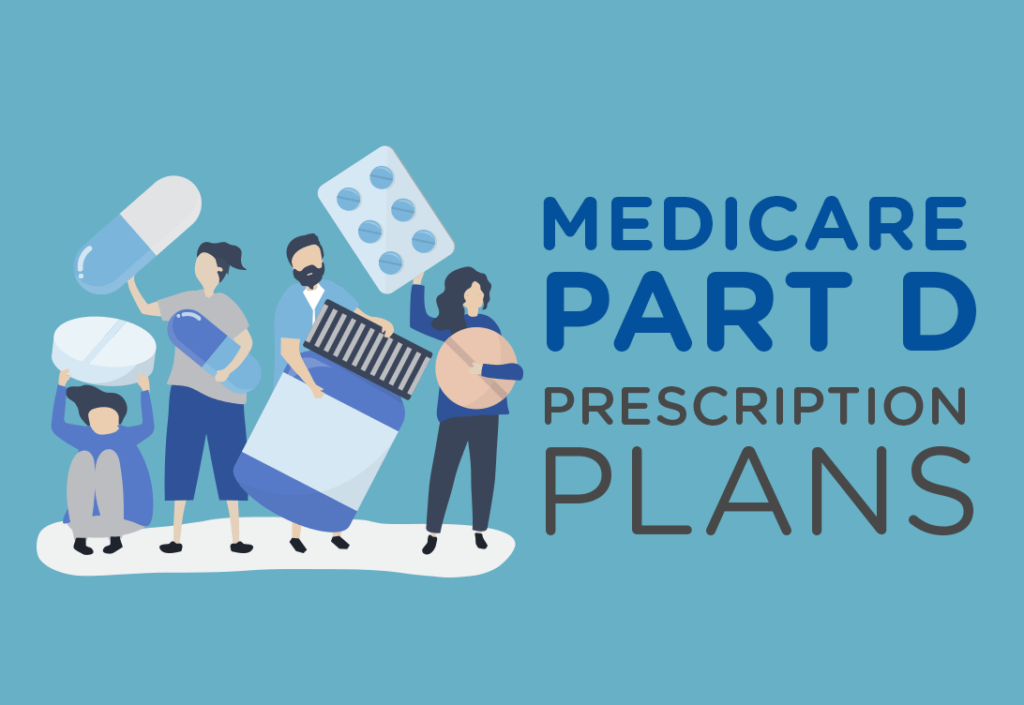
At a certain point in your life, you’ll need to consider switching from private health insurance to a Medicare plan. Medicare Parts A and B are mandatory, while Parts C (Medicare Advantage Plan) and D (Prescription Drug Coverage) are optional. In this guide, we will take a closer look at Medicare Part D. More specifically, we will outline how Medicare Part D works, what it covers, and what it costs.
Agent Tip
Medicare Part D and Medicare Supplement Plan D are two completely different plans. Part D covers prescriptions and Medicare Supplement Plan D helps cover the 20% Medicare doesn’t pay.
What Does Medicare Part D Cover?
Generally speaking, Medicare Part D covers the cost of prescription drugs. You’re probably asking yourself, “Hey, isn’t that what Medicare Part B is supposed to cover?” Yes and no. While Part B does cover some medications, it doesn’t cover everything.
Part B only covers drugs provided at a doctor’s office or hospital. For example, if you visit the hospital and receive an injection, Part B will likely pay for it. However, if your doctor prescribes a medication that you need to pick up at a pharmacy or receive through the mail at a later date, Part B will NOT cover the costs.
Since you acquire Part D through private insurance companies (in partnership with Medicare), the kinds of drugs that your plan covers will vary by provider. However, most Part D plans provide both brand-name and generic prescription drug coverage. At a minimum, every provider must cover two options within the most common drug categories, meaning that Plan D will provide drug coverage for the vast majority of conditions.
Learn More: Do Medicare Supplement Plans Include Prescription Coverage?
Do I need a drug plan if I don’t take any prescriptions?
While Medicare Part D is not mandatory, more than two-thirds of Medicare beneficiaries enroll in a Part D plan. Since most other Medicare plans don’t cover prescription drugs, Part D can save you a lot on medications. But what if you don’t take any prescriptions?
While it is a valid question, it also misses the primary selling point of Medicare. You purchase a healthcare plan even when you’re healthy so that you’re covered when you get sick. The same principle applies to Medicare Part D. You may not need prescription drugs at the moment, but you may need them in the future.
How Does Part D Work With Original Medicare or a Supplemental Plan?
There are several different ways to combine Medicare Part D with other health plans. Let’s take a closer look at some of the most common scenarios:
Original Medicare + Part D
For many people, Parts A, B, and D cover the majority of conditions and medical costs. So, once you enroll in Medicare Parts A and B, you can also obtain a stand-alone Part D plan to help pay for prescription drugs. If you choose this route, you will need to search for a Part D plan on your own.
Medigap + Part D
Medicare Supplement Insurance, also known as Medigap, provides additional coverage for things like copayments and deductibles. Medigap does not provide RX coverage, so many choose to add a stand-alone Part D plan. Combining Medigap and Part D ensures that you’re covered for regular medical expenses that don’t fall under Parts A and B, as well as prescription drugs.
Medicare Advantage + Part D
A Medicare Advantage Plan combines the benefits of Plans A and B. In most cases, a Medicare Advantage Plan provides prescription drug coverage (though this can vary by provider). As a result, you cannot have both a Medicare Advantage Plan and a stand-alone Part D plan at the same time.
Check out our Medicare FAQ page for commonly asked Medicare questions!
When Can I Sign Up for Medicare Part D?
The open enrollment period for newly eligible people is the same for Medicare Part D as it is for Parts A and B.
If you are a US citizen or permanent resident, you can enroll in Medicare Part D up to 3 months before your 65th birthday. This open enrollment period lasts for about seven months.
If you miss the initial enrollment period, you can still sign up for a Part D plan every year between October 15th and December 7th. There are also Special Enrollment Periods (SEP) for people who meet specific requirements. For example, if you recently left a group health plan with your employer, you are eligible to sign up for a Part D plan during a Special Enrollment Period.
Read More: Medicare Open Enrollment For 2020: What Are My Options?
When Can I Change My plan?
You can change your plan anytime during the Annual Enrollment Period (between October 15th and December 7th). If you miss this period, you will have to wait until the next year’s enrollment period to switch plans.
How Much Will I Pay for My Prescriptions?
Now let’s look at the impact Part D will have on your wallet. There are four stages of Medicare Part D related to the amount you pay:
Deductibles
Like any form of Medicare, Part D does not cover 100% of the costs. Every Part D plan as a yearly deductible that, as of 2024, cannot exceed $545 (deductibles vary by provider). So, this means that you will have to pay up to the first $545 worth of prescription drugs every year before Medicare will begin to cover the costs. On many plans, the deductible only applies to tiers 3-5. It is important to carefully check the summary of benefits for the plan you are considering purchasing.
Initial Coverage Period
Once you’ve paid your deductible, the initial coverage period begins. The initial coverage period refers to a certain amount ($5,030 in 2024) paid for prescription drugs every year (by both you and your plan). After this amount has been paid, you reach what is known as a “coverage gap.”
Coverage Gap
During the coverage gap, you must pay a set percentage of the cost of medications. As of 2024, the coverage limit (or the amount that signals the end of the initial coverage period and beginning of a coverage gap) is $5,030. You can read more about the coverage gap here.
Catastrophic Coverage
Medicare Part D also includes Catastrophic Coverage to limit the amount you pay out-of-pocket on prescription drugs every year. Medicare sets a limit ($8,000 in 2024) for how much you can spend on medication before your Catastrophic Coverage kicks in. It assures you only pay a small coinsurance amount or copayment for covered drugs for the rest of the year.
The Donut Hole Explained
You might have heard the term “Donut Hole” associated with Medicare Part D. While it may sound a bit strange, this is simply another way to refer to the coverage gap. As previously stated, the coverage gap kicks in when both you and your insurance provider have reached the initial coverage limit. Once this happens, you will begin paying more for your prescription drugs.
Fortunately, Medicare considers the full cost of drugs when you’re in the “donut hole” (as opposed to the amount you pay), allowing you to move into the catastrophic coverage phase as quickly as possible.
Conclusion
Medicare Part D is one of the best ways for Medicare beneficiaries to save money on prescription drugs. However, it’s important to remember that you can incur penalty fees if you sign up for Part D after the deadline.
thumb
If you have any questions about Medicare Part D or would like to learn more about cost-sharing Medigap options, give us a call at (800) 208-4974 today!
